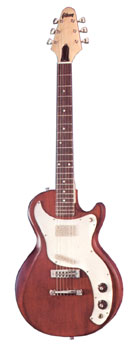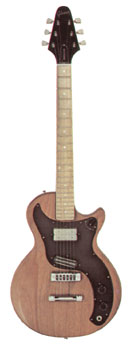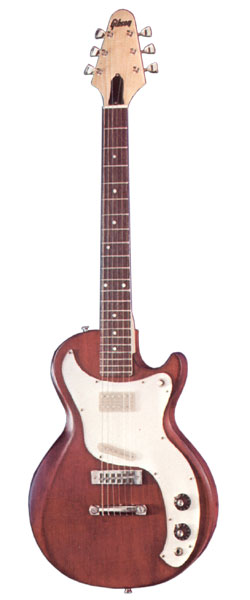The Gibson Marauder was launched in 1974 (actually Marauder shipping records state just 1 instrument was shipped in 1974) and remained in production until 1979; being replaced by the Gibson Sonex series around 1980. This Norlin-period Gibson was produced initially at the Kalamazoo plant, but gradually production transferred to the newer Nashville plant. There was a period in the late 1970s (certainly in 1978) when the model was shipped simultaneously from both plants.
This was Gibson's mid-seventies budget model; still a Gibson and not cheap, but certainly their lowest price electric; though there was a more up-market version, the Marauder Custom, that only shipped in very small numbers. The 1970s were a difficult time for American guitar companies: the oil crisis of 1973, and ensuing recessions, added to competition from Japanese manufacturers, meant ways had to be found to cut costs of at least the entry level models which bore the brunt of competition.
Taken from the Gibson 78 promo magazine:
“The Gibson Marauder guitar was introduced in 1974. The instrument has a body shape rather like a Les Paul, but has a bolt-on neck. The body and neck are made from poplar and hard maple and the instrument is finished in clear satin lacquer. There are three distinct tone settings on the Marauder's selector switch. The front pickup is similar to the Super Humbucker with small additional magnets reinforcing and directing the field, while the bridge pickup has a single, iron-cored coil, with a magnet below and iron strips from the lower magnet pole. The fast, easy-action neck is made from Canadian maple. The fingerboard is made from rosewood with dot inlays and the distinctive peghead is of "V-series" design.”
The Marauder was launched at the same time as the Grabber bass and shared some of its cost cutting features. Both had controls and pickups assembled onto the pickguard; an easier production method than mounting electrics into the guitars themselves. Also both had bolt-on maple necks and alder / poplar bodies. These woods, aswell as being cheaper than Gibson's staple, mahogany, are more traditionally associated with Gibson's main American rival, Fender. A further nod to Fender comes in the choice of pickup; one humbucker at the neck, and a single coil pickup at the bridge. Along with the body shape, and asymmetrical pickguard, the guitar does resemble a Fender Telecaster custom, whilst its sister model the S-1 was built to capture the essence of a Fender Stratocaster

1975 Gibson Marauder. Notice the 3-way switch, and witch hat knobs

1977 Gibson Marauder. The 3-way switch is replaced by a chicken head switch, and it is now fitted with speed knobs

1978 Gibson Marauder. Notice the maple fingerboard, and black scratchplate

Gibson Marauder chronology
- 1974 Marauder launched, however only 1 instrument shipped in the first year [1]
- 1975 First appearance in a price list. The Gibson Marauder promotional record is released; a 45 rpm 7 " vinyl demonstrating the guitar with, and without accompaniment. Finishes: Natural Satin ($349), Wine Red ($399). By the second price list of the year, the Marauder was being called the M-1, and the Marauder Custom was announced (Sunburst only) at $449 [3]
1975 Gibson catalog
- 1976 Marauder Custom price raised to $499 (M-1 prices unchanged [4])
The second price list of '76 raised the price of the Natural Satin finish M-1 to $359, and offered a Natural Maple Gloss instrument for $399. By late 1976 the three-way pickup switch had been replaced by a pot, allowing more subtle blends of bridge and neck pickup; initially this was in the same location as the three-way switch.
- 1977 M-1 Natural Satin $399, Wine Red / Maple Gloss $449. Marauder Custom $539 [5]
- 1978 Again more price rises announced in January. M-1 Natural Satin $419, Wine Red / Maple Gloss $469. Marauder Custom $559 [6]. The May price list of the same year drops completely the Marauder Custom. New finishes for 1978 include Ebony, Walnut and Tobacco Sunburst, Natural Mahogany (on mahogany bodied instruments) [7] and White [8]. In Mid '78, the scratchplate was changed to single-ply black, and very shortly afterwards reshaped, to match that of the Gibson S-1. At this point, the blend-pot was also relocated between the tone and volume controls. Fretboards seem to be exclusively maple from this point. These were obviously good moves as this is the peak year for Marauder sales [1]
Marauder production ends in Kalamazoo and moves exclusively to Nashville towards the end of 1978.
1978 Gibson catalog
- 1979 Price reduced to $399, Walnut being the only available colour. [9]
- 1980 Model officially discontinued [10], though some instruments were made as late as early 1981
- 1981 The last Marauders to ship were manufactured in 1981, including some in Red (probably Devil Red - note - this is a solid colour, Gibson colour code DR; not to be confused with translucent Cherry, colour code CH). Have a closer look at a 1981 Marauder here. The Marauder is included in the Gibson Specials pre-owners manual. Listed finishes are Ebony, White and Red. Unlike the examples produced 1978-1980, these Marauders had a painted neck (rather than bare wood - though there are a few 1978 examples with painted necks), and a rosewood (rather than maple) fretboard.
- 1982 Gibson 'Special Sale' price list [11], includes the Marauder at a dealer price (retail price not listed) of $259.50 - listed finishes are Ebony, White and Cherry Red (but this may be an error and refer to Devil Red?).
1) Gibson Shipment Totals 1937-79 by Larry Meiners
2) Gibson pricelist 1/1/1975
3) Gibson pricelist 20/6/1975
4) Gibson pricelist 1/3/1976
5) Gibson pricelist 1/1/1977
6) Gibson pricelist 15/1/1978
7) Gibson pricelist 15/5/1978
8) Gibson 1978 international catalogue
9) Gibson pricelist 30/9/1979
10) Gibson News, June 1980
11) Special Sale pricelist, February 15th 1982
Got an opinion on the contents of this page? Disagree with something written above? Please
comment





